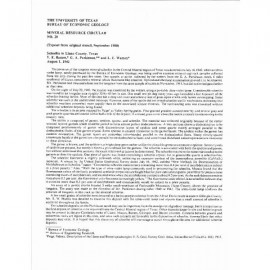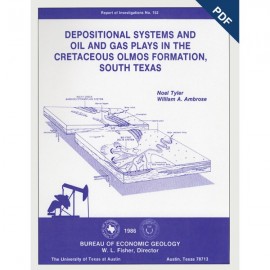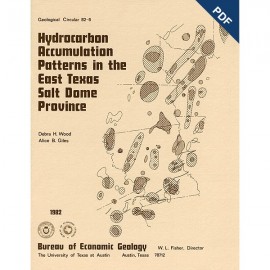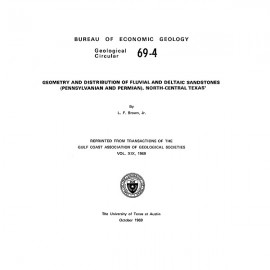Geological Circulars
-
Books & Reports
- Reports of Investigations
- Guidebooks
- Udden Series
- Geological Circulars
- Down To Earth
- Atlases of Major Oil and Gas Reservoirs
- Texas Memorial Museum Publications
- Environmental Geologic Atlas of the Texas Coastal Zone
- Mineral Resource Circulars
- Other Reports
- Seminars and Workshops
- Handbooks
- Submerged Lands of Texas
- Symposia
- Annual Reports
- Open File Reports
-
Maps & Cross Sections
- Thematic Maps
- Miscellaneous Maps, Charts & Sections
- Geologic Atlas of Texas
- STATEMAP Project Maps
- Geologic Quadrangle Maps
- Cross Sections
- Highway Geology Map
- Energy and Mineral Resource Maps
- Shoreline Change and Other Posters
- Wilcox Group, East Texas, Geological / Hydrological Folios
- Bouguer Gravity Atlas of Texas
- River Basin Regional Studies
- Featured Maps
- Posters
- Teachers & the Public
-
Geological Society Publications
- Gulf Coast Association of Geological Societies
- Alabama Geological Society
- Austin Geological Society
- Corpus Christi Geological Society
- Houston Geological Society
- Lafayette Geological Society
- Mississippi Geological Society
- New Orleans Geological Society
- South Texas Geological Society
- GCS SEPM Publications
- Historic BEG & UT Series
Depositional Systems and Structural Controls of Hackberry Sandstone Reservoirs in Southeast Texas
GC8407
A free, digital version of this publication can be found on: Texas ScholarWorks
GC8407. Depositional Systems and Structural Controls of Hackberry Sandstone Reservoirs in Southeast Texas, by T. E. Ewing and R. S. Reed. 48 p., 20 figs., 2 tables, 1984. ISSN: 0082-3309 Print.
To purchase this publication as a PDF download, please order GC8407D.
ABSTRACT
Deep-water sandstones of the Oligocene-age Hackberry unit of the Frio Formation contain significant quantities of oil and gas and remain potentially one of the most productive exploration targets in southeast Texas. The Hackberry is a wedge of sandstone and shale containing bathyal fauna that separates upper Frio barrier-bar - strandplain sandstones from lower Frio neritic shale and sand. Major Hackberry sandstones lie atop a channeled unconformity that forms the base of the unit. Sandstones in a typical sand-rich channel at Port Arthur field grade upward from a basal, confined channel-fill sandstone to more widespread, broad, fan-channel deposits, Topmost are proximal to medial fan deposits and overbank turbidite deposits. The sequence suggests that Hackberry sandstones were laid down by an onlapping submarine canyon-fan complex deposited in canyons that eroded headward into the contemporaneous Frio barrier system. Regional maps and seismic interpretations outline a network of sand-filled channels extending from the barrier toward the southeast.
The earliest structural activity of the Port Arthur area is lower Oligocene (Vicksburg) faulting associated with continental-slope sedimentation. Small growth faults of late Oligocene (Frio) age displace the Hackberry section less than 500 ft and extend upward into Miocene strata. Isopach and isolith maps indicate that the Orange, Port Neches, and Fannett salt domes were active uplifts during Frio and Anahuac (Lower Miocene) deposition. Near Spindletop dome, however, only a north-south-trending salt-cored ridge is present. The Hackberry channels are in part located in salt-withdrawal basins, but major channel axes extend across the uplifts. Time versus depth plots of water depth and sediment thickness indicate that most of the Hackberry Embayment in Texas could have been formed by normal subsidence during the later Oligocene if the embayment were cut off from its supply of muddy sediment. Thick, sandy, lower Hackberry deposits filled deep canyons eroded into the retreating shelf margin.
The Hackberry contains two hydrocarbon plays. The updip play is relatively shallow and oil-rich and lies near the updip limit of deep-water deposition. Some of the fields in this play produce from barrier-bar - strandplain Frio sandstones erroneously correlated with the Hackberry. The downdip play is gas-rich and generally geopressured. The reservoirs lie either within or on the flanks of the major channel systems and are commonly bounded updip by small growth faults, Understanding the component depositional environments represented by the discontinuous and complex lithofacies of these sandstones will improve hydrocarbon exploration and production.
Keywords: Frio Formation, growth faults, Gulf Coast, Jefferson City, oil and gas fields, Orange County, reservoir rocks, salt tectonics, Texas, turbidites
Citation
Ewing, T. E., and Reed, R. S., 1984, Depositional Systems and Structural Controls of Hackberry Sandstone Reservoirs in Southeast Texas: The University of Texas at Austin, Bureau of Economic Geology, Geological Circular 84-7, 48 p.






